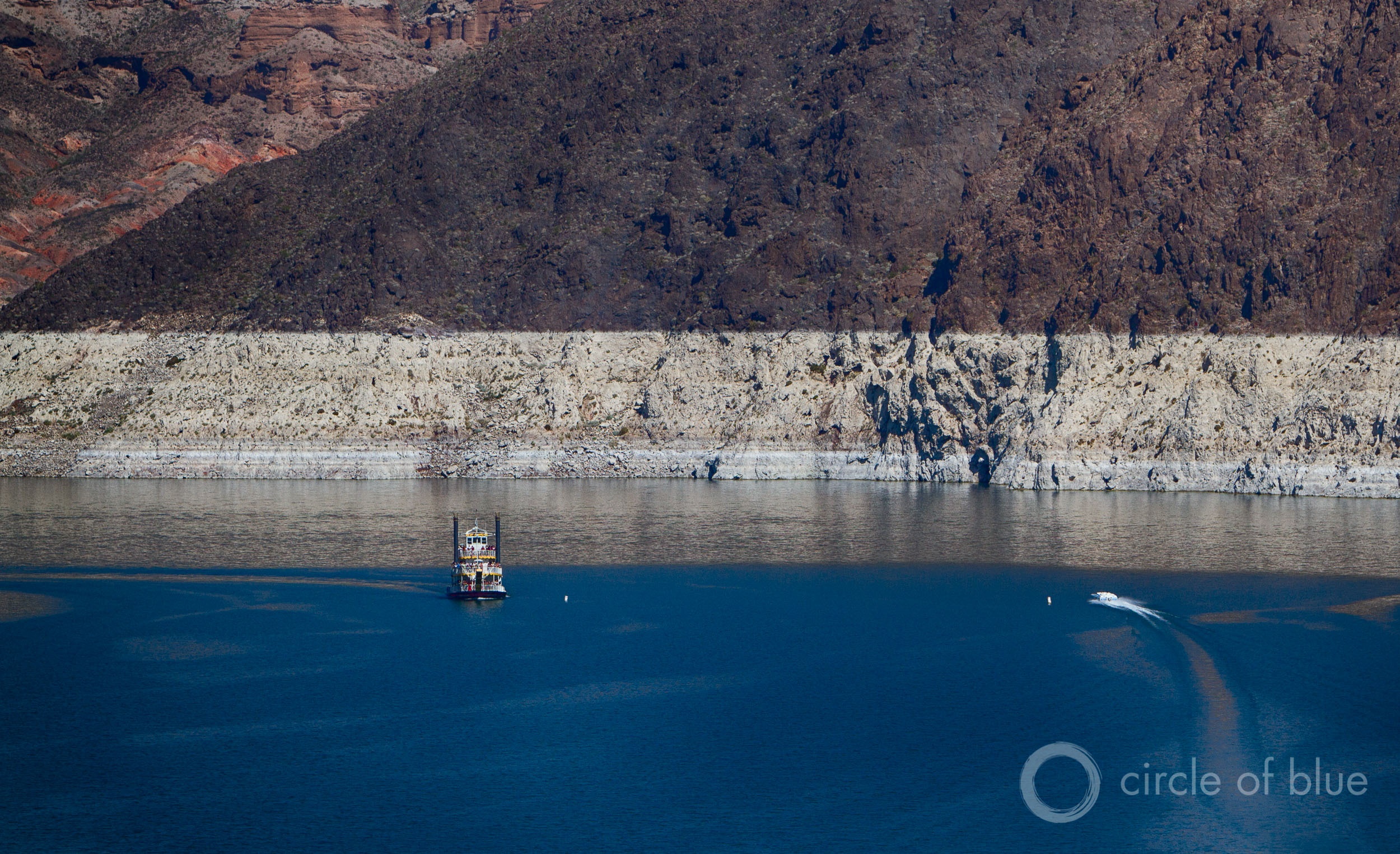Federal government declares, for the first time, a Tier 1 shortage due to low water at Lake Mead.

Mineral deposits on the canyon walls show where Lake Mead water levels used to touch. The reservoir is the lowest it’s been since it was first filled in the 1930s. Photo © J. Carl Ganter / Circle of Blue
- The federal government acknowledged changing conditions in the drying American Southwest on Monday, declaring a Tier 1 shortage for the lower Colorado River basin.
- The Tier 1 shortage was triggered because the water level in Mead is projected to be 1,065 feet above sea level at the end of 2021 — 10 feet lower than the shortage threshold.
- Mead and Powell, the basin’s largest reservoirs, are the lowest they have been since they were first filled. Each is about one-third full.
By Brett Walton, Circle of Blue – August 17, 2021
The implications of the drying American Southwest and the limits to the region’s water supply are steadily becoming more apparent.
The federal government acknowledged the changing conditions on Monday, declaring a Tier 1 shortage for the lower Colorado River basin. The shortage declaration will force Arizona and Nevada, as well as Mexico to further reduce their withdrawals from the river in 2022. California, the other lower basin state, is not affected. The declaration also sets the stage for more drastic measures in the near future since Lake Mead is projected to fall another 30 feet over the next two years.
“We are seeing the effects of climate change in the Colorado River basin through extended drought, extreme temperatures, expansive wildfires, and in some places flooding and landslides. And now is the time to take action to respond to them,” said Tanya Trujillo, Department of the Interior assistant secretary for water and science.
[bctt tweet=”The federal government declared a Tier 1 shortage for the first time due to low water at Lake Mead, making the implications of the drying American Southwest and limits to the region’s water supply more apparent.” username=”circleofblue”]
Mead and Powell, the basin’s largest reservoirs, are the lowest they have been since they were first filled. Each is about one-third full.
The lower basin was already in a Tier Zero shortage this year, which required modest reductions in water withdrawals from the river by users in Arizona, Nevada, and Mexico. Even so, total water storage in the basin’s reservoirs dropped from 49 percent of capacity at this time last year to 40 percent today. The decline was due to a dry spring and parched soils, which resulted in the second-lowest runoff into Powell on record.
A Tier 1 shortage will demand deeper cuts from the lower basin. Nevada and Mexico will be affected, but the cuts will mostly fall on Arizona, and more specifically, to farmers in Arizona who receive water from the Central Arizona Project canal.
Expecting a shortage and an 18 percent cut in water deliveries from the Colorado River, Arizona officials planned for the reductions. Farmers will pump more groundwater and some will be paid to use less water. Arizona will also draw on water it has stored in Mead due to conservation in previous years. Taking into account these and other measures, the cuts will not be as severe as the headline figure of 18 percent.
Tom Buschatzke, director of the Arizona Department of Water Resources, said that the challenge of responding to drier and hotter conditions and declining reservoirs “will be daunting.” He added that it will require local, regional, national, and international collaboration.
The shortage declaration is based on the results of the Bureau of Reclamation’s 24-month study, a simulation of reservoir levels two years into the future that is updated monthly. The August study sets the operating conditions for the next year, meaning the amount of water that is released from the basin’s largest reservoirs, Powell and Mead.
The Tier 1 shortage was triggered because the water level in Mead is projected to be 1,065 feet above sea level at the end of 2021 — 10 feet lower than the shortage threshold.
The cuts may not be as effective in arresting Mead’s decline as previously hoped. That is because Mead will be buffeted by what’s happening upstream at Powell. Besides the shortage declaration, the 24-month study also determines water releases from Mead’s sister reservoir. Because Powell has also declined, less water than usual will be released into Mead — only 7.48 million acre-feet next year from Powell instead of 8.23 million or 9 million.
The Bureau of Reclamation expects that the reduced releases, along with extra water released from reservoirs higher in the watershed, will stabilize Powell. But Mead will be rocked. The big reservoir is projected to decline another 30 feet by August 2023. At that point, a key node in the Southwest’s water supply network would be just 26 percent full.
Even with the shortage announcement, federal officials are looking to the future and what a changing climate means for a watershed that provides more than 40 million people in some of the country’s fastest-growing regions with a portion of their drinking water.
Recent dry conditions could get worse, said Camille Touton, the Bureau of Reclamation deputy commissioner. Scientists say that the basin is tapped out and that officials should be planning for severely reduced inflows, even as states in the upper basin are eyeing increased diversions. Touton said that additional actions to reduce water use “will likely be necessary in the near future.”
What those actions might be — and who would bear the brunt of the reductions — will be on the table when the basin states begin renegotiating interim guidelines that govern the operation of Mead and Powell. Those guidelines expire at the end of 2025, and discussions are expected to begin later this year.
Brett writes about agriculture, energy, infrastructure, and the politics and economics of water in the United States. He also writes the Federal Water Tap, Circle of Blue’s weekly digest of U.S. government water news. He is the winner of two Society of Environmental Journalists reporting awards, one of the top honors in American environmental journalism: first place for explanatory reporting for a series on septic system pollution in the United States(2016) and third place for beat reporting in a small market (2014). He received the Sierra Club’s Distinguished Service Award in 2018. Brett lives in Seattle, where he hikes the mountains and bakes pies. Contact Brett Walton




